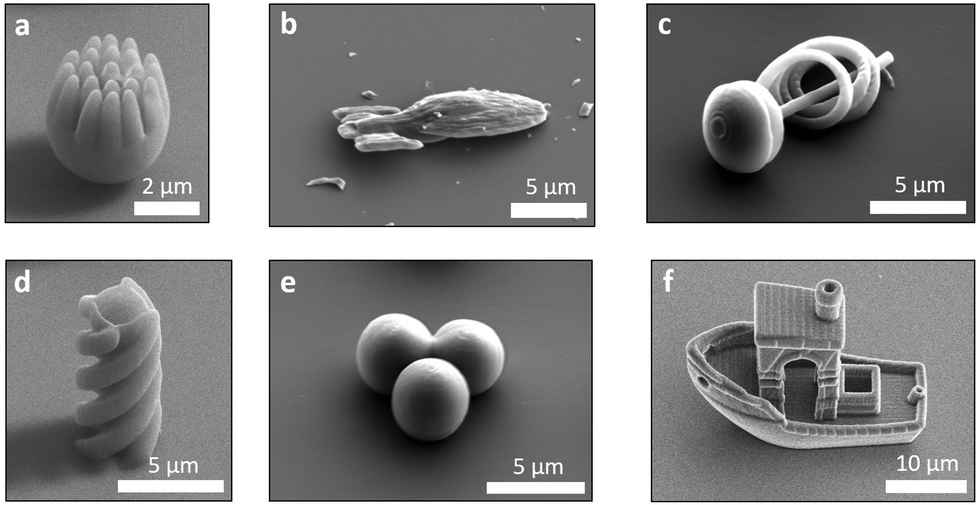A team of physicists from Leiden University have used 3D printing to produce complex microswimmers and other structures at the micron scale. The structures, which resemble spiky spheres, boats, and spaceships, can be used to study various species of bacteria in water.
Artificial microswimmers are typically sphere-shaped. They are employed in research projects to understand the motility of their biological counterparts in fluids. Applications include the development of autonomous drug delivery devices, which emulate the propulsion techniques of naturally occurring biological particles.
3D printing swimmers at the microscale
To date, the 3D printing of active matter has generally been limited to particles larger than ten microns, and projects tend to stick to creating quite simple shapes. The physicists used the Nanoscribe Photonic Professional GT two photon polymerization system. Initially, a set of simple spherical particles between the sizes of one and ten microns were printed – this served to determine the smallest spherical size that could be printed using the technology.
Once the parts were printed, the sequence involved placing them in propylene glycol methylether acrylate (PGMA) for 30 minutes to develop. They were then dipped in isopropanol (IPA) for a total of five rounds. After being left to air dry, the structures were coated with a catalytically active 5 nm layer of Platinum/Palladium (Pt/Pd) using a Cressington 208HR sputter-coater.
According to the study, spheres smaller than four microns in diameter were difficult to produce, giving an indication of the limits of the technology. When placed in water, the particles exhibited Brownian motion, which showcases erratic and random fluidic movements as a result of the surrounding molecules in the vicinity – similar to how smoke or steam move.

The world’s smallest benchy
With the proof of concept out of the way, the Leiden researchers decided to attempt some more sophisticated geometries. Included in these geometries was the classic 3D benchy, a staple benchmarking tool in the 3D printing community; a helical pasta-like screw; and even a spaceship.
The 3D benchy, reportedly the smallest to ever be 3D printed, measures just 30 microns across, about a third of the thickness of a single human hair. The boat has an array of features such as portholes and open cabins, intended to illustrate how a 3D printer handles tasks such as bridging and overhangs.
The other more serious structures exhibited shape-dependent behavior, proving the potential of the 3D printing method. The scientists plan to launch a wide range of follow-on studies focused on improving the control and design of similar synthetic microswimmers, paving the way for applications in therapeutic diagnostics and drug delivery.

Research into nanoscale 3D printing
Earlier this month, a team of researchers from the Karlsruhe Institute of Technology (KIT) developed a novel photoresist, a printing ink for two photon lithography, capable of self-assembly. The material can be used to 3D print polymer microstructures with nanoscale porosities. The self-assembly concept depicts how individual particles can be programmed to assemble themselves into complex synthetic geometries. The process is usually limited to a relatively small spatial scale and previous attempts to create such structures on a human scale have failed.
Elsewhere, researchers from Purdue University developed a 3D printed capsule that is capable of sampling bacteria inside the human stomach. The 3D printed pill is able to capture bacteria (known as biome), not just in the colon, but the entire gastrointestinal tract. The “gut-oscopy” technique could be used with colonoscopy processes in order to better understand intestinal diseases.
The research paper that includes the world’s smallest boat is titled Catalytically propelled 3D printed colloidal microswimmers. It is co-authored by Rachel P. Doherty, Thijs Varkevisser, Margot Teunisse, Jonas Hoecht, Stefania Ketzetzi, Samia Ouhajjia and Daniela J. Kraft.
Check us out on Twitter and Facebook for more updates! Don’t forget to subscribe to the 3D Printing Industry newsletter to keep up-to-date with the latest 3D printing news.
Are you looking for a job in the additive manufacturing industry? Visit 3D Printing Jobs for a selection of roles in the additive manufacturing industry.
Featured image shows 3D Benchy. Photo via Leiden University.


